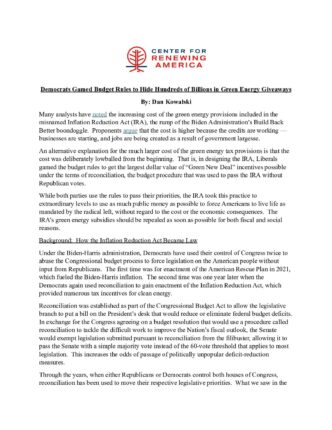
Democrats Gamed Budget Rules to Hide Hundreds of Billions in Green Energy Giveaways
Many analysts have noted the increasing cost of the green energy provisions included in the misnamed Inflation Reduction Act (IRA), the rump of the Biden Administration’s Build Back Better boondoggle. Proponents argue that the cost is higher because the credits are working — businesses are starting, and jobs are being created as a result of government largesse.
An alternative explanation for the much larger cost of the green energy tax provisions is that the cost was deliberately lowballed from the beginning. That is, in designing the IRA, Liberals gamed the budget rules to get the largest dollar value of “Green New Deal” incentives possible under the terms of reconciliation, the budget procedure that was used to pass the IRA without Republican votes.
While both parties use the rules to pass their priorities, the IRA took this practice to extraordinary levels to use as much public money as possible to force Americans to live life as mandated by the radical left, without regard to the cost or the economic consequences. The IRA’s green energy subsidies should be repealed as soon as possible for both fiscal and social reasons.
Background: How the Inflation Reduction Act Became Law
Under the Biden-Harris administration, Democrats have used their control of Congress twice to abuse the Congressional budget process to force legislation on the American people without input from Republicans. The first time was for enactment of the American Rescue Plan in 2021, which fueled the Biden-Harris inflation. The second time was one year later when the Democrats again used reconciliation to gain enactment of the Inflation Reduction Act, which provided numerous tax incentives for clean energy.
Reconciliation was established as part of the Congressional Budget Act to allow the legislative branch to put a bill on the President’s desk that would reduce or eliminate federal budget deficits. In exchange for the Congress agreeing on a budget resolution that would use a procedure called reconciliation to tackle the difficult work to improve the Nation’s fiscal outlook, the Senate would exempt legislation submitted pursuant to reconciliation from the filibuster, allowing it to pass the Senate with a simple majority vote instead of the 60-vote threshold that applies to most legislation. This increases the odds of passage of politically unpopular deficit-reduction measures.
Through the years, when either Republicans or Democrats control both houses of Congress, reconciliation has been used to move their respective legislative priorities. What we saw in the Democrat’s use of reconciliation for the IRA, however, is the height of cynicism and outright cheating under the guise of following the rules.
How the IRA Gamed the Reconciliation Rules
The drafters of the IRA gamed the rules in two ways. First, they opted to use tax credits rather than direct grants because tax credits are difficult to score. Second, the tax credits were estimated against an out-of-date baseline that expected much lower economic activity than was actually occurring in the Summer of 2022.
Most federal benefit programs can be structured as either spending programs or tax credits. The cost of a capped grant program for which there is an application process is easier to estimate than an open-ended tax credit program where the taxpayer determines eligibility for the credit. The Congressional Budget Office (CBO) and the Joint Committee on Taxation (JCT) must estimate many unknowns in developing tax credit estimates, which make their estimates less reliable than those for a grant program. If one expects the estimators will understate takeup of the program, choosing tax credits enables the drafters to receive more benefits than the cost assessed to them.
In the case of the green energy credits, the legislation also included an unprecedented conversion of a tax credit to cash through a new “credit monetization mechanism” (Sec. 6417) to ease any hardship this choice may have had on beneficiaries. (Tax credits traditionally are paid annually after a taxpayer first pays its tax liability on a quarterly basis.) This further suggests that the drafters wanted a cash grant program, but opted for a tax credit instead to exploit the ability to receive a bigger program in the future through the open-ended nature of the tax credit.
In addition, the drafters of the IRA used an outdated baseline, which made the credits cost less because they were based on a lower levels of economic activity and lower expected inflation.
The post-pandemic economic recovery occurred much more quickly than forecasters had estimated. This led to significant revisions to the baseline revenue outlook between the official forecasts of February 2021 and July 2021. According to CBO’s July 2021 Economic and Budget Outlook, the revenue outlook for fiscal years 2022 through 2031 improved by $1.442 trillion (2.9%) based solely on economic factors (see Table A-1 https://www.cbo.gov/system/files/2021-07/51118-2021-07-budgetprojections.xlsx). The revision was not surprising given that the US economy was largely locked down with Covid-era restrictions while the baseline was being prepared.
The FY 2022 budget resolution (S.Con.Res. 14) was based on CBO’s July 2021 Economic and Budget Outlook, which was appropriate when the budget resolution was agreed to in August 2021. Negotiations on the Inflation Reduction Act concluded in early August 2022, a whole year after consideration of the budget resolution.
CBO updated its baseline estimates in May 2022—after the budget resolution was agreed to but before the reconciliation process was concluded. Between July 2021 and May 2022, CBO estimated that the revenue outlook improved by an additional $2.059 trillion (4.0 percent) solely due to economic factors (see Table A-1 https://www.cbo.gov/system/files/2022-05/51118-2022-05-Budget-Projections.xlsx), reflecting the increase in inflation from the American Rescue Plan.
Despite this known increase in baseline revenue estimates, the fiscal effects of the IRA’s revenue provisions were based on the outdated and lower revenue baseline. It is not clear why the Joint Committee on Taxation (JCT) did not adjust its baseline. As common sense would suggest, the agency typically will adjust its baseline to account for changes to macroeconomic conditions (see footnote 2 here https://www.jct.gov/publications/2023/energy-estimates-for-pl-117-169/), but did not do so in this case. Instead, JCT used the 2021 baseline to determine the fiscal effect of the policies in the IRA (ibid. p.3).
JCT admits that its estimates of the cost of the green energy provisions would have been higher had they used the May 2022 estimates: “had the 2022 CBO forecast been incorporated for the revenue estimate of the IRA, the predicted revenue losses would have been commensurately higher (ibid. p. 4)” because of changed economic conditions. JCT goes on to explicitly say the CBO baseline that underlies a “revenue estimate may have a significant effect on the predicted Federal revenues (ibid.)”. It is clear the cost of the Green New Deal would have been much higher than scored for purposes of the reconciliation bill had JCT followed normal procedures.
This failure to use the latest information matters because, under reconciliation rules, a reconciliation submission cannot increase the deficit in any fiscal year after the period of years covered by the budget resolution. The outyear deficit neutrality test prevents a Committee from using one-time savings to offset ongoing increases in the deficit and remain in compliance with the budget’s reconciliation instructions. It prevents committees from gaming the system.
Engineering a cost estimate that is lower than what it should be based on current knowledge allows for reconciliation legislation that unambiguously increases the deficit in defiance of the process and to the detriment of taxpayers. That’s what happened with the IRA. Having an accurate score would have made it more difficult to meet the outyear deficit reduction test (that is, they would have had to spend less). Defaulting to an outdated baseline enabled the Committee to put 10 pounds in a 5-pound sack.
Some have argued that the reconciliation process needed to stick with the scoring that staff were using when negotiations began because it would have been too difficult to switch from the old estimates. That argument is disingenuous. It would have been technically possible for JCT to adjust its estimates and Committee staff could have tallied up the new results. Some decisions may have needed to be revisited, but that is part of the legislative process when faithfully using the budget rules.
Democrats showed no respect for the budget rules in enacting the IRA. The budget process was only respected as a vehicle for one-party rule rather than the original intent as a vehicle to bring revenues and expenditures into better alignment.
Further, the differences in the estimates likely would have been substantial as a result of the $2.1 trillion estimate in higher revenues from economic changes. An analysis of the changes in JCT’s annual estimates of energy tax expenditures (see JCT x-22-22 and x-59-23) suggests that the costs would have more than doubled. Over the four common years of the tax expenditure reports, JCT’s estimates increased in 2023 by $165 billion; extrapolating to 10 years suggests an increase of roughly $400 billion would not be unreasonable, doubling the $391 billion cost of the original legislation.
Call to Action
There are rumblings that some conservatives are not as interested in repealing the IRA green energy subsidies as they once were. Beneficiaries like the subsidies; they were paid because they were enacted through reconciliation, which does not allow outyear deficits; and they are now in the baseline, so removing them would be a tax increase.
As this analysis shows, liberals did not pay for the IRA green energy subsidies. They expected costs to grow rapidly over time, and chose tax credits rather than grants to receive the upside without paying for the added cost. They also retained an outdated baseline that made the credits look cheaper against a smaller economy than was being currently observed. Liberals cheated and only paid for a portion of their cost outside of the budget window. In the real world, their cost is multiples of the $391 billion budgeted.
With the nation $35 trillion in debt, removing tax pork must be on the table as much as unwarranted spending to bring deficits under control. These subsidies are spending by another name, lodged on the revenue side of the ledger to take advantage of congressional budget rules.
In addition, the Liberal’s subsidies are harming industry, resulting in over 5,000 layoffs in traditional automobile manufacturing to deploy more capital into electric vehicle manufacturing.
Industrial policy to promote clean energy vehicles is not supported by most Americans, who are not interested in electric vehicles, and it stifles innovation in the use of America’s abundant traditional sources of energy such as oil and gas.
Conservatives should lead the charge to return choice to American consumers and remove costly subsidies that clearly increase deficits and debt by repealing the green energy provisions of the IRA.




